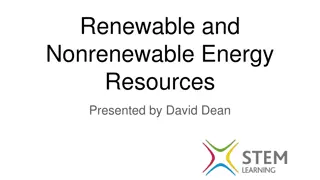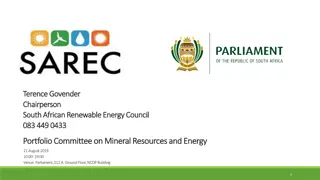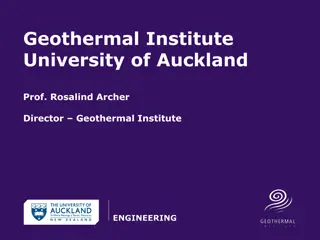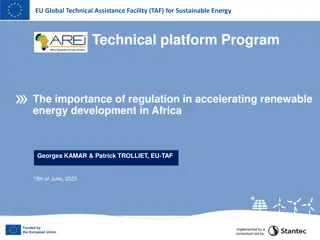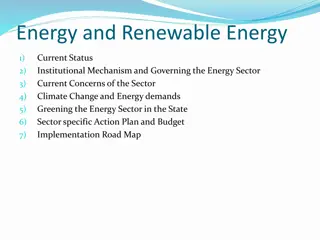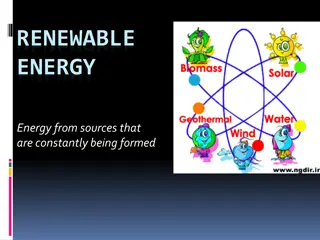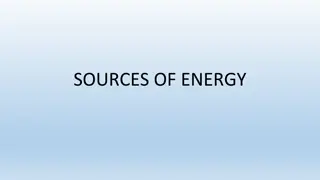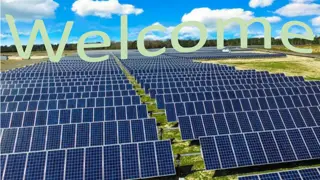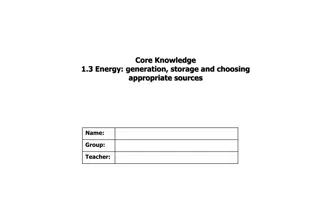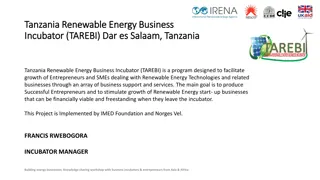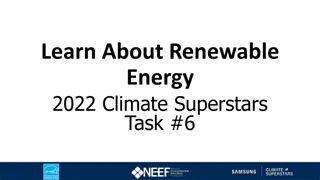Renewable Energy: Sources, Advantages, and Disadvantages Overview
Comprehensive guide for practitioners on renewable energy sources, advantages, and disadvantages, exploring topics from fossil fuels to net zero technologies. Includes activities, resources, and links for Level 2 and Level 3 qualifications in engineering and manufacturing.
Download Presentation

Please find below an Image/Link to download the presentation.
The content on the website is provided AS IS for your information and personal use only. It may not be sold, licensed, or shared on other websites without obtaining consent from the author. Download presentation by click this link. If you encounter any issues during the download, it is possible that the publisher has removed the file from their server.
E N D
Presentation Transcript
Renewable energy 1. Sources, advantages and disadvantages of renewable energy
Practitioner guide 1. Sources, advantages and disadvantages of renewable energy 2
1. Sources, advantages and disadvantages of renewable energy | Practitioner guide Introduction and overview These resources help practitioners to deliver the renewable energy components of engineering and manufacturing-related qualifications at levels 2 and 3. They introduce the topic and stimulate learners to explore and reflect on key concepts and are designed to complement and enhance practitioners own lesson materials and schemes of work. Resources summary Resource name Level PPT slides + notes practitioner PPT slides learner Activity sheets Film Interactive 1. Sources, advantages and disadvantages of renewable energy 2 2 Delivery Delivery suggestions for practitioners, and suggested answers where appropriate, are in the presenter s notes for each slide. The core activities in each resource provide around 60 mins of learning time, though additional suggestions, including independent learning, can extend this time significantly. The Level 3 resources explore making energy and power calculations and consider how solar and wind power can be combined to provide low-carbon power for a manufacturing plant, exploring seasonal variations, before making ballpark calculations for the UK. They explore how other emerging technologies can be implemented alongside renewables to create a smart distributed grid that is responsive to dynamic changes in supply and demand, and how learners engineering careers can contribute to the transition to a net zero economy. Overarching theme/big questions How can renewable energy meet current and future demand? Overview The Level 2 resource reviews the need for renewable energy as an alternative to fossil fuels that contribute to climate change and helps learners to consider some advantages and disadvantages of each form, and how they might help to power the UK. 3
1. Sources, advantages and disadvantages of renewable energy | Practitioner guide Learning outcomes and resource links Level 2 resource Sources, advantages and disadvantages of renewable energy Full resource list available for the topic of Renewable energy: 1. Sources, advantages and disadvantages of renewable energy (Level 2) 2. Planning for renewable energy (Level 3) 3. Delivering renewable energy (Level 3) Explain the link between fossil fuel consumption and climate change. Suggest some advantages and disadvantages of different forms of renewable energy. Links to other supported topics Identify some challenges and opportunities related to a transition to renewable energy. Battery technologies, Electrical machines, Innovation and emerging technologies, Sustainability. Identify engineering career opportunities related to renewable energy. 4
1. Sources, advantages and disadvantages of renewable energy | Practitioner guide Subject coverage Renewable energy Including careers Energy from fossil fuels Examples of career opportunities related to renewable energy and net zero technologies Fossil fuels and climate change Forms of renewable energy Advantages and disadvantages of renewable energy Nuclear energy Sources of renewable energy in the UK 5
1. Sources, advantages and disadvantages of renewable energy 6
1. Sources, advantages and disadvantages of renewable energy Learning outcomes You will be able to: Suggest some advantages and disadvantages of different forms of renewable energy. Explain the link between fossil fuel consumption and climate change. Identify some challenges and opportunities related to a transition to renewable energy. Identify engineering career opportunities related to renewable energy. 7
1. Sources, advantages and disadvantages of renewable energy How do we get electricity from fossil fuels? Power generation transforms energy from one form into another. Power station water steam Cooling tower Combustion Turbine Generator steam Fossil fuel Discuss and list how you have used energy today: at home, to get to college or school, and during the day. What are the three forms of fossil fuel? Can you explain how they were formed and when? What energy transformations take place in this power station? What do the solid black arrows represent? 8
1. Sources, advantages and disadvantages of renewable energy How are fossil fuels changing the Earth s climate? Fossil fuels and power generation Fossil fuels include coal, oil and gas, formed millions of years ago from the remains of dead plants and animals. In a fossil fuel power station: Atmospheric carbon Combustion Chemical energy > Heat > Kinetic energy > Electrical energy The black arrows represent how the carbon stored in fossil fuels is released by combustion into the atmosphere as carbon dioxide. Respiration Photosynthesis What do the orange arrows represent in this carbon cycle? Decay The carbon cycle Fossil fuel What do the black arrows represent? What is the significance of the black arrows? Can you explain the meaning of the greenhouse effect ? 9
1. Sources, advantages and disadvantages of renewable energy Fossil fuels, energy and climate change answers Fossil fuels and climate change The orange arrows in the carbon cycle diagram represent natural carbon cycles that change very slowly over time. Atmospheric carbon Combustion The black arrows represent human processes that have rapidly added carbon into the atmosphere. The greenhouse effect is the natural process by which certain gases trap the sun s heat, warming the Earth. The rapid rise in atmospheric carbon has amplified the greenhouse effect, leading to global warming and the current climate crisis. Respiration Photosynthesis Decay The carbon cycle Fossil fuel Renewable energy sources provide a solution to the problems of climate change. Can you define a renewable energy source? 10
1. Sources, advantages and disadvantages of renewable energy Introducing renewables Renewable energy is energy that is collected from resources that are naturally replenished on a human timescale. Wind Hydro Solar Wind generation converts the kinetic energy of moving wind into electricity. Hydro generation converts the kinetic energy in flowing water into electricity. Solar generation converts radiant energy from the sun into electricity. Solar panels can be mounted on roofs or in ground-level solar farms. Wind turbines can be located in onshore or offshore wind farms. This requires water to be stored at altitude, or to be readily available. 11
1. Sources, advantages and disadvantages of renewable energy Introducing renewables Tidal Biofuels Geothermal Tidal energy converts the kinetic energy in flowing tidal streams. Biofuels are fuels produced from plant materials, including bioethanol, biodiesel and oils. Geothermal energy extracts heat stored in deep rocks. This requires fast-flowing, deep tides for a large volume of water. The heat is used directly or to generate electricity. Fast-growing biofuel crops are grown on farmland. Think carefully about how each form of renewable energy can be harnessed and used. Identify at least one advantage and disadvantage of each form. List some advantages of combining renewable sources of energy. 12
1. Sources, advantages and disadvantages of renewable energy Advantages and disadvantages of renewables Combining renewable energy sources overcomes many limitations. Different areas can make the most of local renewable resources. Different sources can help to balance out differences between supply and demand. Wind Solar Hydro Biofuels Geothermal Tidal Easily scaled up Easily scaled up Reliable Portable Reliable Reliable Advantages Can be offshore Can use roofs Lots available Output varies with conditions Unevenly distributed Unevenly distributed needs mountains Uses land that could be used to grow food Unevenly distributed Expensive Disadvantages Marine habitat damage Output varies with conditions Expensive Which other engineering technologies might help to make renewables as reliable and dependable as our current energy supply? 13
1. Sources, advantages and disadvantages of renewable energy Renewables and nuclear energy Nuclear energy is non-renewable but is often considered alongside renewable energy. The heat from fission reactions is used as a replacement for the combustion of fossil fuels. Nuclear energy can offer significant advantages but also significant disadvantages: Nuclear Advantages No carbon emissions during operation. Enormous amounts of energy from uranium fuel. Uranium supplies are predicted to last well over 200 years. Disadvantages Hazardous, long-lasting nuclear waste. Very expensive and slow to build. Very expensive and slow to decommission. Decide whether you think nuclear energy should form part of a zero carbon energy system in the future be ready to justify your position. 1414
1. Sources, advantages and disadvantages of renewable energy How could we become a renewable UK? The UK offers many possibilities for harnessing renewable energy, but these are not evenly distributed. Public opinion can also play a role in how renewable energy sources can be used. Consider how different forms of renewable energy could each contribute to a UK that is 100% powered by renewables. Label the map with your ideas about how some or all forms could be more widely implemented across the UK. Identify some challenges and how these might be overcome. 15
1. Sources, advantages and disadvantages of renewable energy How could we become a renewable UK? The UK has some of the world s best conditions for wind energy, and about half of Europe s available tidal energy. Solar energy is most available in southern regions. Offshore wind around the coast and in the North Sea, but needs expensive maintenance and connection to the mainland. Tidal energy is available along the west coast and where strong tides occur but needs to avoid damage to marine environments or shipping. Solar generation mainly in the south and west, but needs to work alongside farming and food security. Existing hydro in mountainous regions new forms of energy storage may be cheaper to build. Onshore wind in hilly and coastal areas, but needs to overcome visual objections. 16
1. Sources, advantages and disadvantages of renewable energy Renewable energy and engineering careers Planning and feasibility Identifying and modelling opportunities for renewable energy generation. Design Designing wind turbines and solar panels, or installations like wind or solar farms. Construction Constructing new wind and solar farms, or other forms of renewable generation. Maintenance Making sure renewable generation stays safe and efficient. Distribution and integration Linking renewable generation to the national grid. Energy storage Designing, building and maintaining new battery grid storage to even out supply to meet demand. 17
1. Sources, advantages and disadvantages of renewable energy Learning outcomes You will be able to: Suggest some advantages and disadvantages of different forms of renewable energy. Explain the link between fossil fuel consumption and climate change. Identify some challenges and opportunities related to a transition to renewable energy. Identity engineering career opportunities related to renewable energy. 18













